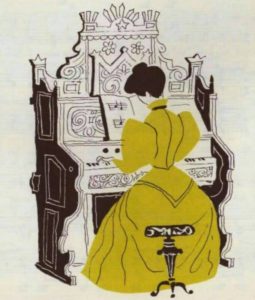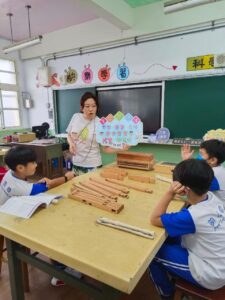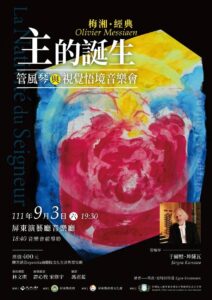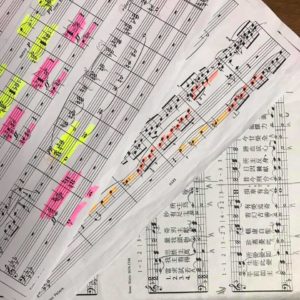Orgelkids China執行長蔣士挺(Justin Berg)「兒童管風琴教育專欄」【初因初音】。
『Aristide Cavaille-Coll』from the column【My First Sound】 by Justin Berg, the Executive Director of Orgelkids China. (In English below)
過去一百年當中,有許多發明徹底改變了我們的生活,你知道是哪幾項嗎?大多數的現代人已經無法想像,如果沒有電腦、智慧型手機或網路,要怎麼活下去;那個沒有現代化交通工具或居家設備的世界,已經離我們非常遙遠了,根本無法想像。有太多嶄新又複雜的東西,是藉著融合和改造原有的東西和技術而創造出來的,智慧型手機就是一例,是把先前的技術和製造過程加上全新的想法和新興的科技,得到極為創新的結果,徹底改變人際溝通和社會互動的過程。
雖然我們不常想到,但樂器也在過去幾個世紀裡經歷無數的創新,其中有一些是漸進式的,也有一些則是激烈發生,而19世紀管風琴的情形就是後者,雖然有許多人與這個演變有關,但當中有一位法國人格外重要,他將原有的管風琴建造技術結合當代的創新方法,發展出前所未有的管風琴,獲致極為特別的成就,無法在此簡述。要真正了解他對於管風琴工藝的獨特貢獻,我們需要實地走訪幾個目前尚存的管風琴實品,尤其是在法國各地的管風琴。但是在此之前,我們還得先回到更早的年代,了解法國17世紀和18世紀的管風琴,這些管風琴的聲音啟發了這位19世紀的才子,所以我們需要先對這些管風琴有點認識。因為我們要探索的是兩個不同世代的法國管風琴建造方式,我打算把這篇簡介分成兩個部分,本文先介紹舊式的管風琴,再用另一篇文章探討19世紀管風琴建造大師卡發耶科爾的作品。
在拿破崙勢力鼎盛的時候,也就是他在1812年進攻俄國之前,法國已熬過二十多年的社會和政治劇變。拿破崙重新建造了法國社會的傳統結構,他計畫要藉著各種不同的政治聯盟,使法國的版圖和影響力激增。而在這陣混亂當中,音樂與藝術都持續蓬勃發展,部分原因就是拿破崙的支持,此外則是因為人類永遠渴望美感。其實拿破崙本身也很愛好義大利歌劇,經常觀賞歌劇演出,他也很喜愛熱鬧的號角聲和軍事盛典。因此我們不難想像,拿破崙對管風琴也很有興趣,即使不是因為管風琴在法國教堂裡的宗教功能,至少會因為管風琴的莊嚴雄偉的音色。無論真正的原因有哪些,管風琴建造家在拿破崙所統治的19世紀前25年相當活躍。
在那個政治社會都不確定的年代,誕生了一位日後大大改變法國管風琴製琴過程,也改變全世界管風琴家和聽眾品味的小男孩。卡發耶科爾在1898年辭世之前,就已經是有史以來最具影響力的管風琴建造天才,他在1811年2月4日出生於一個管風琴建造家的家庭,他父親製作的樂器在南法的隆格多克地區相當聞名,而卡發耶科爾也向兄長學習管風琴建造的相關工作。他在22歲時前往巴黎就學,不久後就贏得聖德尼教堂管風琴重建競賽,這座教堂正是法國歷代君王的陵墓 (附圖)。為了符合這項挑戰,他父親就把管風琴建造工廠遷到巴黎,開始進行工作,於是卡發耶科爾很快就把事業發展到法國各地甚至全世界。
卡發耶科爾最早期的重要成就即為重建聖德尼大教堂的管風琴,這座教堂就在巴黎近郊,現在已被指名為他最初嶄露鋒芒的地點,也預示著他將對管風琴建造家、演奏家和聽眾正在發展的品味造成權威式的影響。在探索聖德尼教堂和後續管風琴的創新設計之前,我們卻需要先回顧十九世紀初法國管風琴建造的情形,以及造成那個情況的傳統,因為卡發耶科爾為聖德尼教堂建造的管風琴有一部分的靈感是來自古典法國管風琴建造的某些成分,並且重新思考另一些成分。(待續)
你的朋友蔣士挺
〜Aristide Cavaille-Coll (part I)〜
Think of all the inventions over the past century that have revolutionized the way we live: How many can you name? For most of us, life without computers, smart phones or the internet is barely imaginable. Even a world without modern transportation or the comforts of a modern house is so long gone that it’s basically intangible. In many instances, new and complex things have been created through the fusion and adaptation of existing items and technologies. Smart phones are one example of the intersection of earlier technologies and manufacturing processes with new ideas and emerging technologies. The result has been monumentally innovative, changing the course of communication and social interaction.
Though we don’t often think about it, musical instruments have also undergone numerous innovations over the centuries, sometimes incremental, other times radical. The latter was the case with the organ throughout the nineteenth century. Though many people were involved in that transformation, it was one Frenchman in particular who consolidated previous organ building achievements with the innovations of his time to develop an instrument unlike any organ that had been heard before. So extraordinary were his achievements that they cannot easily be summarized here. To truly understand the importance of this person’s contributions to the art of the organ, we would need to visit several of his surviving instruments around the world, particularly throughout France. Before we do that, though, we need to travel back even further in time to visit French organs from the seventeenth and eighteenth centuries. The sounds of those organs inspired our nineteenth-century genius, so we first need to learn a little about them. Since we are exploring two different eras of French organ building, I have decided to divide this article into two parts: first we will look at those older organs, and then in the next article turn our attention to the work of the nineteenth-century master, Aristide Cavaille-Coll.
By the time Napoleon reached the apex of his powers, just prior to his invasion of Russia in 1812, France had already survived some two decades of drastic social and political upheaval. Napoleon himself had reengineered the traditional structure of French society and had schemed to balloon the country’s size and influence through various political alliances. Yet amidst all this turmoil, music and the arts continued to thrive, thanks in part to Napoleon’s patronage, but also to the enduring human desire for beauty. In fact, the Emperor was a great admirer of Italian opera, frequently attending performances, and he was also a lover of raucous fanfare and military pageantry. Given this aspect of his character, perhaps it is not much of a stretch to imagine that Napoleon appreciated the organ, if not for its religious function in French churches, at least for the sheer grandeur of its sound. Whatever the reason, organ builders remained active during his turbulent reign in the first quarter of the century.
Into this world of political and social uncertainty was born the boy who would greatly alter the course of French organ building and the tastes of organists and their audiences the world around. Up to 1898, the year before his death, Aristide Cavaille-Coll remained one of the most influential geniuses the organ building world has ever produced. On February 4, 1811, Aristide was born into a family of organ builders. In fact, his father’s instruments were well known in the Languedoc region of southern France, and Aristide actually learned the trade of organ building from his brother. By the age of 22, he moved to Paris for studies, and very shortly after his arrival won the competition to rebuild the organ at St. Denis, the famed church of French kings in generations past. To meet this challenge, his father’s organ building firm relocated to Paris to begin the work. And so Aristide’s career swiftly soared across France and eventually the world.
Today, Cavaille-Coll’s first major achievement, the rebuilding of that organ at the Basilica of St. Denis, just outside Paris, is typically cited as the initial manifestation of his brilliance as well as a harbinger of his magisterial influence on the developing tastes of builders, performers and listeners alike. Before exploring the innovations found at St. Denis and in subsequent organs, however, we need to survey the state of French organ building at the turn of the nineteenth century and the tradition that led to that point, since Cavaille-Coll’s organ for St. Denis drew inspiration from certain aspects of Classical French organ building while reimagining others.
(To be continued.)
Your Friend,
Justin





